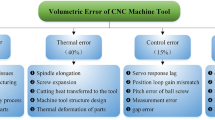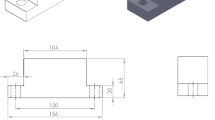Abstract
Complex surface parts are widely used in the industrial applications, and 5-axis NC machining with ball-end cutter is the commonly adopted method for curved surface parts. Due to the additional rotary feed axis comparing with 3-axis NC machining, the tool orientation control is complex for curved surface machining. With the more complexity of curved surface parts, it is a known problem that the large incoherent movement of the rotary feed axis will easily appear in curved surface machining, which may even be beyond the kinematical performances of the rotary feed axis in machine tool, so as to affect the machining quality of curved surface parts. In order to overcome this issue, an optimization method of tool axis vector based on the kinematical characteristics of the rotary feed axis for curved surface machining is proposed. Firstly, the optimizing interval of the toolpath for tool axis vector is selected based on the relationship between the rotation angle of rotary feed axis and the accumulation arc length of toolpath. Then, the equalization method of tool axis vector based on the quaternion method is used to optimize the tool axis vector with the kinematical characteristics of rotary feed axis. Finally, the angular change curve of rotary feed axis with the optimized angular value and cumulative arc length is adjusted by the principle of least-squares fitting after the local optimization of tool axis vector. Simulation and experiment on test parts are carried out to verify the validity of the proposed method, and the achievements are significant to improve the processing quality of complex curved surface parts.
Similar content being viewed by others
References
Li WL, Wang G, Zhang G, Li QD, Yin ZP (2017) Interference-free inspection path generation for impeller blades using an on-machine probe. IEEE/ASME Trans Mechatronics 22(3):1218–1226
Wang GX, Shu QL, Wang J, Wang WS (2014) Tool interference checking for five axis NC machining of sculptured surfaces. China Mechanical Engineering 25(3):299–303
Tang TD, Bohez ELJ (2015) A new collision avoidance strategy and its integration with collision detection for five-axis NC machining. Int J Adv Manuf Technol 81(5–8):1247–1258
Yoon JH, Pottmann H, Lee YS (2003) Locally optimal cutting positions for 5-axis sculptured surface machining. Computer Aided Design 35(1):69–81
Ho MC, Hwang YR, Hu CH (2003) Five-axis tool orientation smoothing using quaternion interpolation algorithm. Int J Mach Tools Manuf 43(12):1259–1267
Morisige K, Kase K, Takeuchi Y (1996) Tool path generation using C-space for 5-axis control machining. J Japan Society of Precision Engineering 62(1):1783–1787
Castagnetti C, Duc E, Ray P (2008) The domain of admissible orientation concept: a new method for five-axis tool path optimisation. Computer Aided Design 40(9):938–950
Srijuntongsiri G, Makhanov SS (2015) Optimisation of five-axis machining G-codes in the angular space. Int J Prod Res 53(11):3207–3227
Choi BK, Park JW, Jun CS (1993) Cutter-location data optimization in 5-axis surface machining. Comput Aided Des 25(6):377–386
Grandguillaume L, Lavernhe S, Tournier C (2016) A tool path patching strategy around singular point in 5-axis ball-end milling. Int J Prod Res 54(24):7480–7490
Li LL, Zhang YF, Li HY, Geng L (2011) Generating tool-path with smooth posture change for five-axis sculptured surface machining based on cutter’s accessibility map. Int J Adv Manuf Technol 53(5–8):699–709
Jun CS, Cha K, Lee YS (2003) Optimizing tool orientations for 5-axis machining by configuration-space search method. Computer Aided Design 35(6):549–566
Lavernhe S, Tournier C, Lartigue C (2008) Optimization of 5-axis high-speed machining using a surface based approach. Comput Aided Des 40(10):1015–1023
Geng C, Yu D, Zheng LM, Zhang H (2012) Algorithm of optimization of rotation axes in free-form surface machining. J Mechanical Engineering 48(23):127–134
Li XY, Lee CH, Hu PC, Zhang Y, Yang FZ (2017) Cutter partition-based tool orientation optimization for gouge avoidance in five-axis machining. Int J Adv Manuf Technol 95(5–8):2041–2057
Zhou B, Zhao JB, Liu WJ (2013) Method study on optimization of tool axis vector for complex surface of 5-axis CNC. J Mechanical Engineering 49(7):184–192
Wang N, Tang K (2007) Automatic generation of gouge-free and angular-velocity-compliant five-axis toolpath. Computer Aided Design 39(10):841–852
Luo M, Wu B, Li S, Zhang D (2009) Five-axis tool orientation optimization based on kinematical method. J Mechanical Engineering 45(9):158–163
Wang J, Zhang DH, Luo M, Wu BH (2013) A global tool orientation optimization method for five-axis CNC machining of sculptured surfaces. Acta Aeronautica et Astronautica Sinica 34(6):1452–1462
Acknowledgements
The authors wish to thank the anonymous reviewers for their comments which led to improvements of this paper.
Funding
The project is supported by Science Challenge Project of China (No. TZ2018006-0101-02), National Natural Science Foundation of China (No. 51575087 and No. 51675081), National Science and Technology Major Project of China (No. 2016ZX04001-002), Innovation Project for Supporting High-level Talent in Dalian (No. 2016RQ012), Science Fund for Creative Research Groups (No. 51621064), and the Fundamental Research Funds for the Central Universities.
Author information
Authors and Affiliations
Corresponding author
Rights and permissions
About this article
Cite this article
Ma, Jw., Hu, Gq., Qin, Fz. et al. Optimization method of tool axis vector based on kinematical characteristics of rotary feed axis for curved surface machining. Int J Adv Manuf Technol 100, 2007–2020 (2019). https://doi.org/10.1007/s00170-018-2738-7
Received:
Accepted:
Published:
Issue Date:
DOI: https://doi.org/10.1007/s00170-018-2738-7




